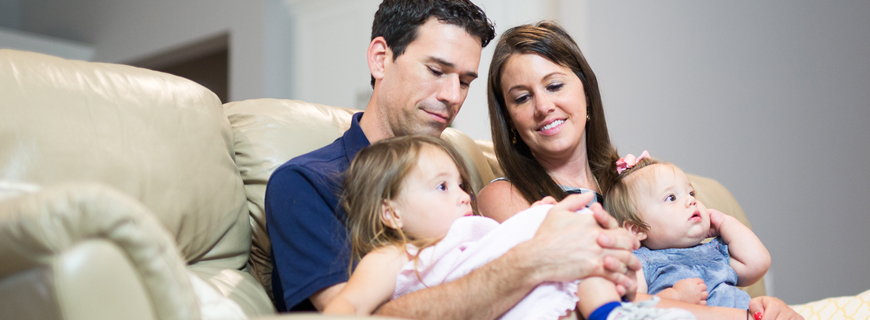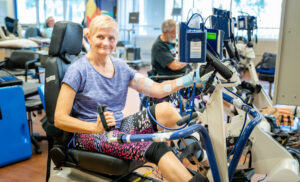Young Mother Almost Dies After Giving Birth

Back to physical health resource hub
After complications while delivering their first daughter, Amanda and Tony consulted with the OB-GYN before trying for a second child. He assured them it was a one-time occurrence. He was wrong.
Amanda was scheduled for a c-section for the birth of her second daughter. As with the first delivery, her uterus would not contract. Amanda was hemorrhaging and the only option was an emergency hysterectomy.
Everyone thought the surgery was a success. Amanda was out of recovery and taken to a room. But when the nurse took Amanda’s vitals that night, she knew something was very wrong.
From Bad to Worse
Amanda’s blood was not clotting and she was bleeding internally. Doctors were faced with a major dilemma. They couldn’t perform surgery to stop the bleeding since she wasn’t clotting. But she was bleeding so profusely that her body swelled to twice its size. The weight was crushing her organs. She was placed on a ventilator because she was no longer able to breathe on her own. They knew they had to do something fast or she would not live to see her newborn daughter.
There was a new drug she could be given to clot her blood. Although there were many risks associated with this particular drug, there was no other choice. She could be given the drug, or she could die.
Tony, their family and clinicians all breathed a sigh of relief when the drug appeared to be working. The bleeding stopped and a team of surgeons were able to successfully operate. She was slowly improving and her condition was no longer life-threatening. Tony took the opportunity to leave the hospital for the first time. He wanted to get home to his newborn baby and 2 ½ year old who were home with Amanda’s parents.
The Stroke
Two hours later, Tony got a call from the hospital. Amanda now had massive bleeding in her brain. The clotting drug created a huge blood clot in her brain, which caused a stroke. She was airflighted to Baptist Downtown. Her chart indicated that she would likely be dead on arrival. “For the second time in five days, we thought we’d be planning her funeral,” said Tony.
But one surgeon took a chance. He said “she’s so young. Let’s try to save her.” He assembled a team that performed a craniectomy and was able to stop the bleeding and remove the clot. Amanda enthusiastically says “I love that doctor!” She owes him her life.
After two and a half months in the hospital fighting for her life, she was transferred to Brooks Rehabilitation Hospital to learn how to get back to her life. The stroke left her unable to walk, talk or eat. She had to re-learn everything. And she had yet to hold her newborn baby girl.
“One of the first things I remember at Brooks was my therapist, Michael Greene, teaching me how to walk again. He told me I was going to walk the stairs and I told him there was no way I was ready. But we walked the stairs. And that gave me the confidence to keep going,” said Amanda. “I just wanted to get home to my girls.”
Knowing Amanda’s goals, her therapist focused on helping her achieve them. They practiced holding a baby doll. They helped her learn how to safely lift and keep up with her 2 ½ year old. Amanda was so motivated in therapy that she was discharged home two weeks later.
Tony heard the loud thump and found Amanda unresponsive on the bathroom floor.”
For some, this might be the end of the story. A young mother heads home to care for her family. However, Amanda had yet another setback.
Amanda was wearing a cushioned helmet to protect her brain after the craniectomy, however, she took it off while resting in bed. When she was ready to get up, she decided not to trouble Tony. She thought she was strong enough to get up on her own. She didn’t remember to put the helmet back on. Tony heard the loud thump and found Amanda unresponsive on the bathroom floor. The latest blow caused full paralysis on her right side and aphasia.
She was transported back to the hospital. After several days, Amanda begged to go back home with her family. She and Tony decided that she would receive therapy on an outpatient basis. She couldn’t bear the thought of leaving her girls again. For the next 5 months, she worked with physical, occupational and speech therapists at Brooks’ Mandarin outpatient clinic to regain mobility and help her find ways to adapt to life with aphasia.
“I still have trouble with buttons and my handwriting is terrible. I get frustrated because I can’t always find the right words to use. But 10 months after almost dying twice, I went back to work full-time. And most importantly, I get to be a wife and a mother to my beautiful girls,” said Amanda.
First Coast News’ coverage of Amanda’s Story
Brooks Rehabilitation is proud to honor Amanda as one of our 2016 Faces of Stroke for her courageous journey to recovery.
#WeAreBrooks


